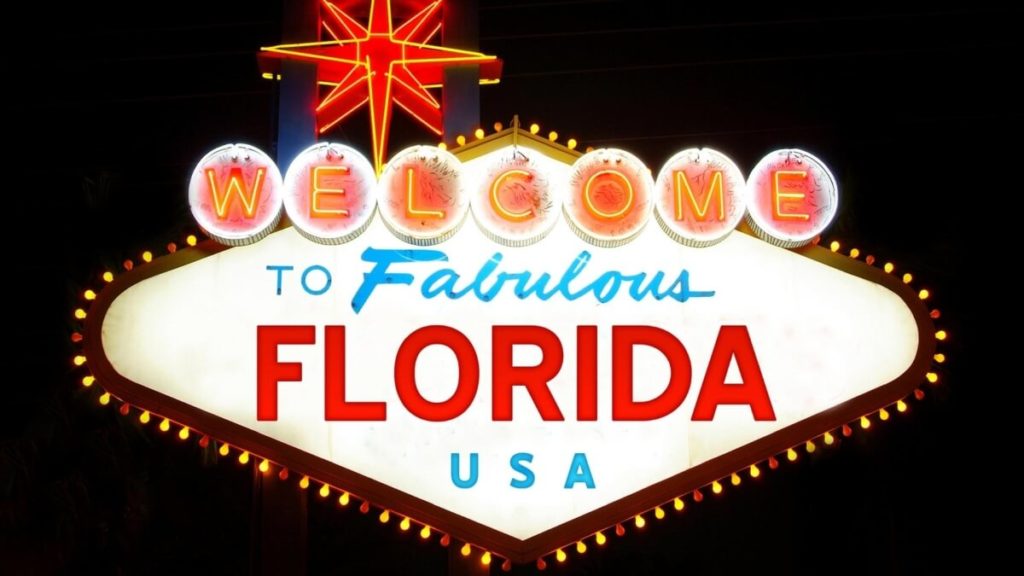
Living or visiting Florida and wondering what bird you’re looking at? This article covers the most common birds of Florida. Odds are high the bird you’re looking at is one of them. It will also inform you on how to identify them.
Birding in Florida
The subtropical State of Florida is home to unique birds found nowhere else, including the
Snail Kite, Limpkin to the White-crowned Pigeon. It’s a birder’s paradise.
Florida has the longest coastline of the Lower 48 states. There are 516 different species of birds, and most of them are year-round inhabitants. Then, of course, there are pine forests and grassland for a diverse landscape and diverse avian residents
Everglades National Park is the largest wilderness park in the eastern part of the U.S. While hiking the park isn’t easy, driving the 38-mile main road will produce an abundance of birding opportunities.
The Anhinga Trail is one of the Everglades’ most popular hikes with a lot of waterbirds such as Ibises, Wood Stork, and Herons, as well as the Short-tailed Hawks, and Cowbirds by the Flamingo Visitor Center.
The Corkscrew Swamp Sanctuary has access to a forest with a 2.25-mile trail winding through the sanctuary that is home to a multitude of wading birds, the Barred Owl, Painted Bunting, and the Pileated Woodpecker. It has a breeding colony of Wood Storks, the most important such nesting site in the country.
J.N. “Ding” Darling National Wildlife Refuge is a 6,400-acre refuge on Sanibel Island and a prime site for birding with greenery and wetland. A popular drive within the Refuge has pelicans, wading birds, and shorebirds, along with Short-tailed Hawks and Osprey, among many others. Fortunate birders may catch sight of the Mangrove Cuckoo or Magnificent Frigatebird.
Myakka River State Park/Oscar Scherer State Park has 38 miles of hiking trails and bird tours that are meant for birders looking for wading birds, the Sandhill Crane, the Swallow-tailed Kite, and others. The nearby Oscar Scherer State Park is the place to spot the Florida Scrub Jay.
Merrit Island National Wildlife Refuge by the Kennedy Space Center consists of dunes, beaches, wetlands, and forests, all of which create homes for 350 different species of birds. The Black Point Wildlife Drive allows birders to explore Herons, Ibises, and Egrets on six convenient hiking trails. There are also Bald Eagles.
Apalachicola National Forest is Florida’s largest national forest with a huge population of Red-cockaded Woodpeckers. Brown-headed Nuthatch and Bachman’s Sparrow can also be spotted here.
Most Common Birds of Florida
Roseate Spoonbill
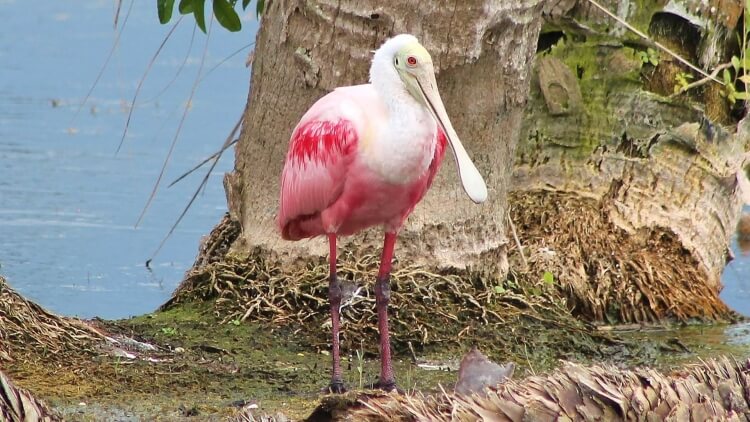
The Roseate Spoonbill is most abundant south of the Florida coast from the Keys to Tampa. They are a vision in pale pink with more pronounced pink shoulders and rump. Their neck is long and white topped by a pale green head. They are named after their large, spoon-like bill. Although they share the same coloring as the flamingo, these two are not related. They grow from 27.9 to 33.9 inches in length and weigh 42.3 to 63.5 ounces with a wingspan of 47.2 to 51.2.
They wade through waters of mangroves, bays, and wetlands and feed on fish.
Brown Pelican
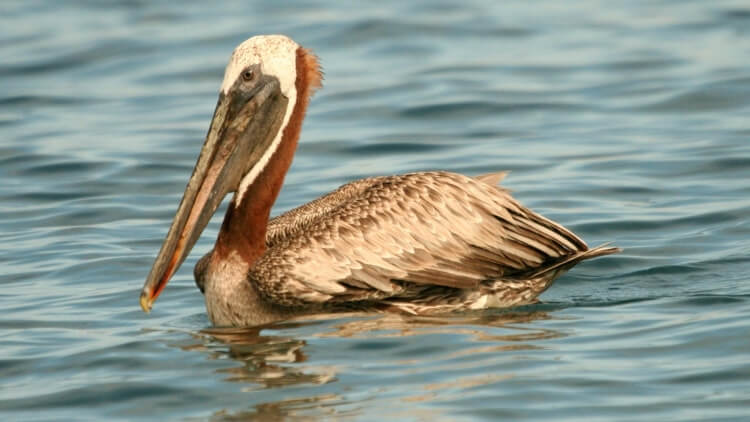
The Brown Pelican can be found throughout Florida, but Pelican Island east of the city of Sebastian is a wildlife refuge that was created specifically for the Brown Pelican. They are large and stocky with a thin neck. They have a noticeable pouch beneath their very long, strong bill they use for scooping fish from the water. Their coloring is gray-brown with a white neck and a yellow spot on their head. For birders familiar with the California Brown Pelican, the Florida resident lacks the red coloring in the pouch.
The Brown Pelican grows to 39.4 to 53.9 inches in length and weighs 70.5 to 176.4 ounces with a wingspan of 78.7 inches.
Caracara
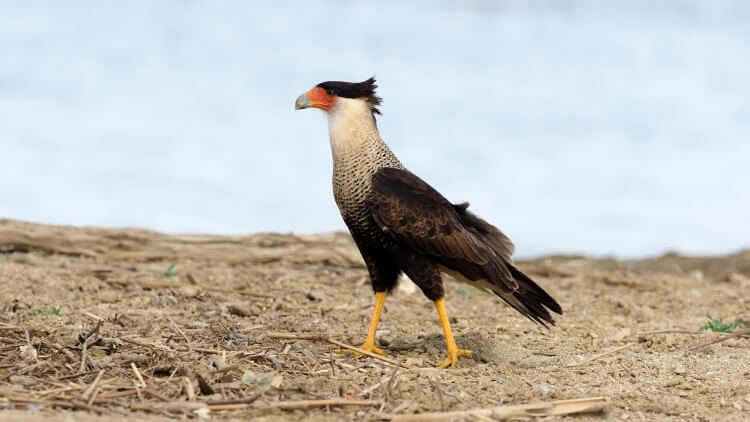
The Caracara can be found between Lake Okeechobee and Lake Kissimmee and surrounding regions. They can also be seen at the St. Johns River near Mims. The Caracara is a bulky, long-legged raptor with a black cap, a white “beard” beneath his orange beak, orange legs, and a spotted throat and back with brown wings. They grow to 19.3 to 22.8 inches in length and weigh between 37.0 to 45.9 ounces with a wingspan between 48.0 to 49.2.
They inhabit deserts and savannas, where they feed on just about anything, including carrion, fish, birds, and small mammals.
Purple Gallinule
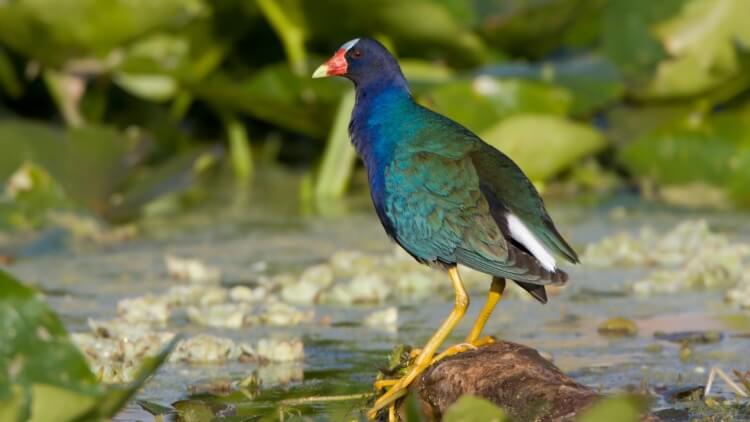
The Purple Gallinule may be Florida’s most gorgeous waterbird and can be spotted in the freshwater march of the Florida peninsula. Brimming with colors, they have a purple head and body, with greenish wings and back and a bright red bill with a yellow tip. Their legs and feet are yellow. They grow to a length of 13.0 to 14.6 inches and weigh 7.2 to 10.3 ounces with a wingspan between 21.6 and 22.1 inches. This bird can be found at the water’s edge as well as perched in trees. They will eat anything, from seeds, fruits, and aquatic plants to frogs, snails, fish, and the eggs of other birds.
Black Birds in Florida
Anhinga
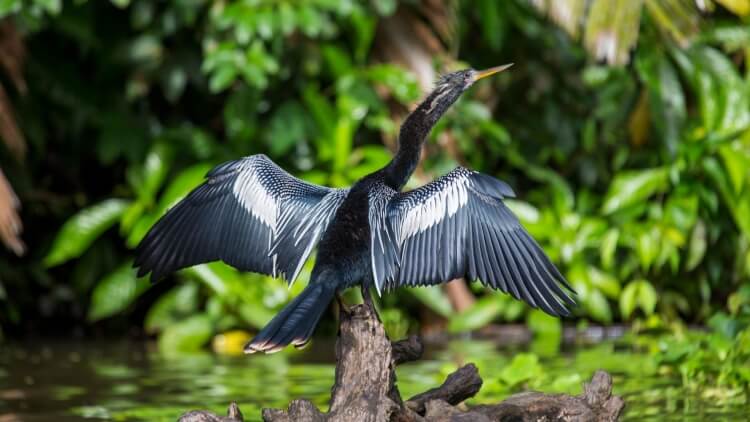
The Anhinga is a large waterbird with a huge fanlike tail. The neck is curved into an “S,” and they have a sharp bill. They are black except for a silver design on their wings and back. The female can be more brown than black. The Anhinga will grow between 29.5 to 37.4 inches in length and weigh between 46.7 and 47.6 ounces with a wingspan of 42.9 inches.
They inhabit areas around lakes, ponds, and streams and feed on fish and aquatic insects. They can be seen in southern Florida near wetlands.
Swallow-Tailed Kite
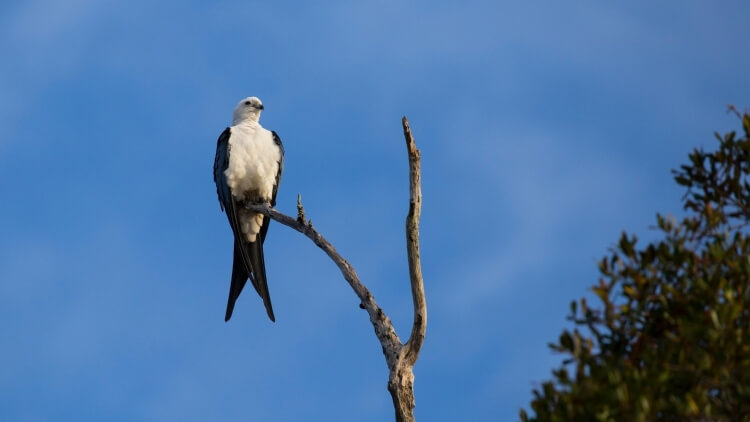
The Swallow-Tailed Kite can best be spotted in late spring or early summer as they migrate through the Panhandle. They have a slim body and a sharply hooked bill. The most magnificent thing about them is the dramatic white and black coloring – pure white head and underbelly and shiny black wings, back, and tail. During flight, the wings are a spectacular display of black and white. They grow 19.7 and 25.2 in length and weigh 13.1 to 21.2 ounces with a wingspan of 48.0. They feed on insects, smaller birds, and frogs.
Boat-Tailed Grackle
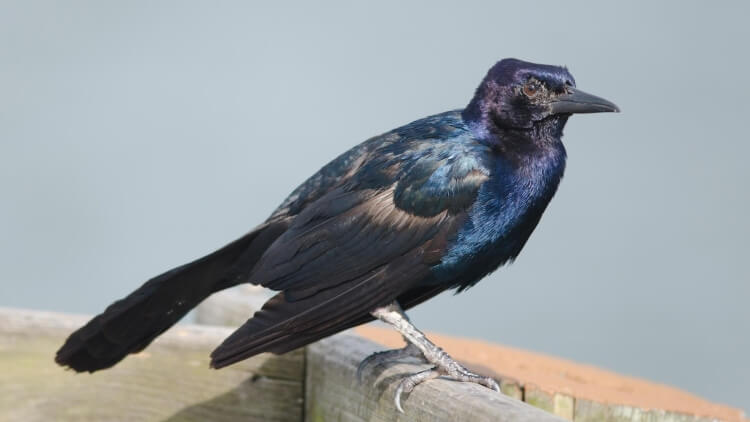
The Boat-tailed Grackle can be found throughout the Florida peninsula. While they are considered coastal birds elsewhere, they live away from the coast in Florida. They are large, and their long tail constitutes close to half of their body size. While the male is an overall glossy black, the female has black wings and a tail with a brown face and body. Both sexes grow between 10.2 to 14.6 inches in length, weigh 3.3 to 8.4 ounces with a wingspan between 15.3 to 19.7. They feed on seeds and aquatic insects.
Blue Birds in Florida
Florida Scrub-Jay
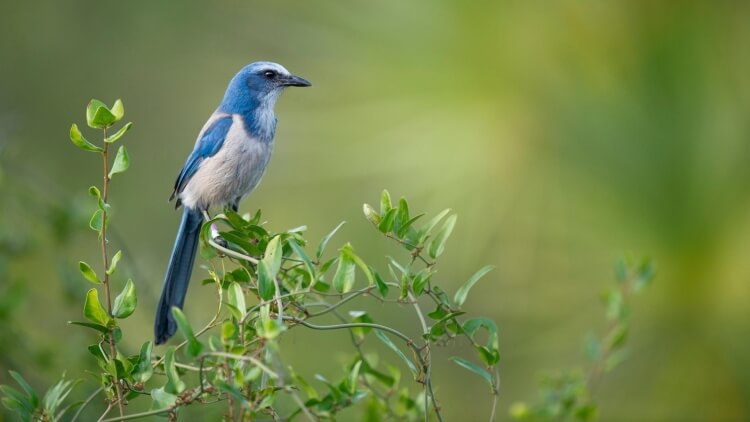
The Florida Scrub-Jay is entirely native to Florida, lives in low-growing oak scrub and sandy flatwood, and cannot be found anywhere else in the world. Birders have an excellent chance of spotting these at the Merritt Island National Wildlife Refuge or Archbold Biological Station. It is a large bird with strong legs and a long tail. It has an overall very light blue coloring with a white patch on its forehead and a pale back and belly. It grows 9.1 to 11.0 inches in length and weighs 2.3 to 33.0 ounces with a wingspan between 13.0 to 14.2.
It picks insects out of shrubs and buries accords for future meals.
Blue-Headed Vireo
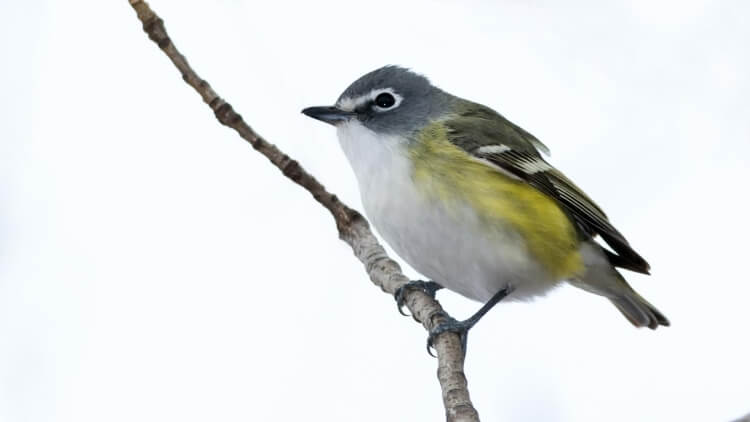
The Blue-headed Vireo is a summer visitor to the canopies of Florida’s forests. It is green-gray with a blue head and a white underbelly. It grows 4.7 to 5.9 inches in length and weighs 0.5 to 06 ounces with a wingspan between 8.7 to 9.5 inches. They can be found on top canopy branches looking for insects, larvae, butterflies, and spiders.
Eastern Bluebird

The Eastern Bluebird is a small plump bird with a large head and short tail and legs. The male is a bright blue above with a rusty throat and breast and a white underbelly. They grow between 6.3 and 8.3 inches in length and weigh between 1.0 and 1.1 ounces with a wingspan between 9.8 and 12.6.
They inhabit meadows, golf courses, fields, and open areas and feed on insects and berries.
Red Birds in Florida
Northern Cardinal

The Northern Cardinal is most prominent in the south of Florida. They are large, quite long-tailed, and have a noticeable thick red bill. The male is a stunning red with a black face, while the female has reddish hues through the wings and tails and is just as stunning. Both have marvelous “just-got-out-of-bed” unkempt tufts on top of their head. The Northern Cardinal grows to 8.3 to 9.1 inches and weighs 1.5 to 1.7 ounces with a wingspan between 9.8 and 12.2.
They can be spotted in backyards, shrubby areas, and parks and forage for bugs, ants, insects, and berries.
Vermilion Flycatcher
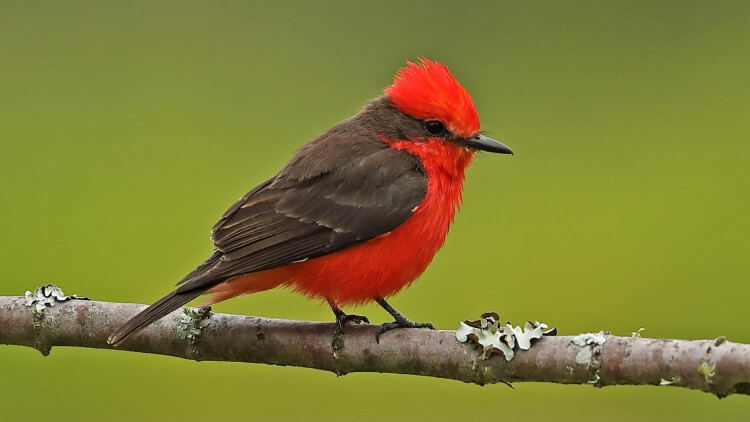
The Vermilion Flycatcher can be spotted in Everglades National Park, Miami-Dade County, and Central Florida. The male is bright red with brown wings, tail, and back and with a mysterious black mask around the eyes. The female is a brownish gray with some blush hues on the underbelly. Both have a black bill. They grow 5.1 to 5.5 inches in length and weigh 0.39 to 0.49 ounces with a wingspan between 9.4 to 9.8.
They inhabit shrubby woodlands and lowlands; they feed by snapping up insects in mid-air.
Summer Tanager
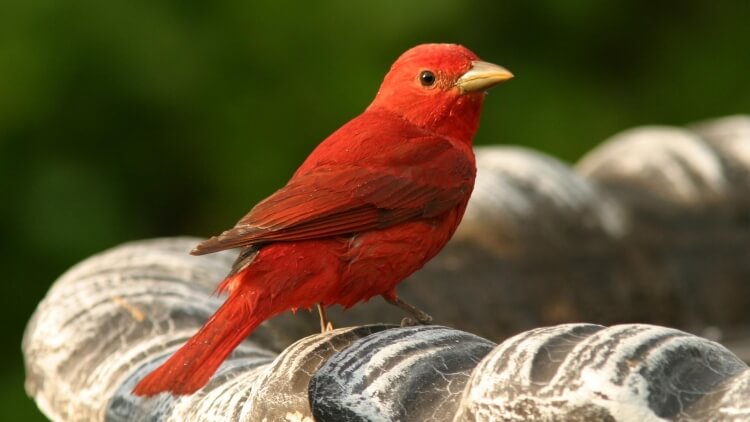
The Summer Tanager can be found in Northwest Florida in the summer before they begin to migrate south. They are medium-sized and chunky, but otherwise, the sexes look entirely different. The male is strawberry red, while the female is yellowish-mustard yellow. Both grow to 8 inches in length and weigh .9 to 1.1 ounces with a wingspan between 11 to 12 inches. They spend their time on the top of tree canopies snapping at insects, including wasp larvae but can be lured into backyards with peanut and suet.
Orange Birds in Florida
Blackburnian Warbler
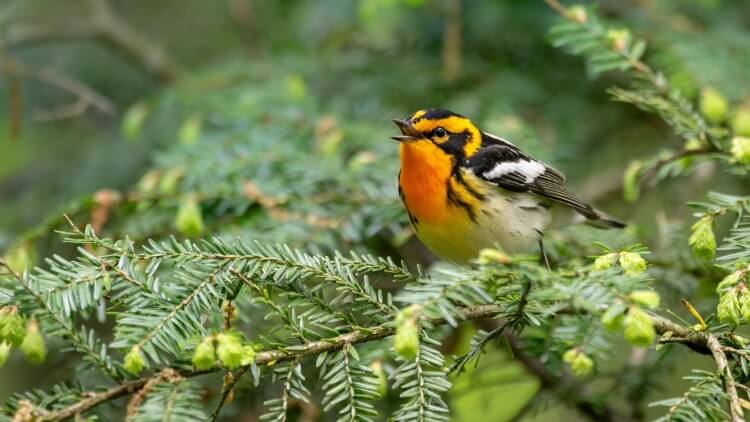
The Blackburnian Warbler can be spotted in Florida during the months of September and October. The breeding male has a bright face and throat, while the female has a much dimmer yellowing coloring that extends to her belly. Both have an unmistakable triangular eye patch. The male’s wings are black and white striped with a pale underbelly. Both grow 4.3 to 4.7 inches in length and weigh 0.3 to 0.4 ounces with a wingspan between 7.9 to 9.1 inches.
They inhabit coniferous forests and feed on the tree’s insects and larvae as well as fruits and berries.
American Robin

The American Robin can be spotted in Florida during the fall and winter. They have a large tail and invariably look color-coordinated with brown-gray wings, an orange belly and underbelly, and a black head. The female is a paler gray and a muter lemony orange. Both have a long, pointy tail. They grow 7.9 to 11.0 inches in length and weigh between 2.7 and 2.0 ounces with a wingspan between 12.2 and 15.8 inches. American Robins can be found in parks, golf courses, fields, and gardens, as well as deciduous and pine forests where they feed on fruits and seeds. They can be lured into a backyard with peanuts, suet, and raisins.
Barn Swallow
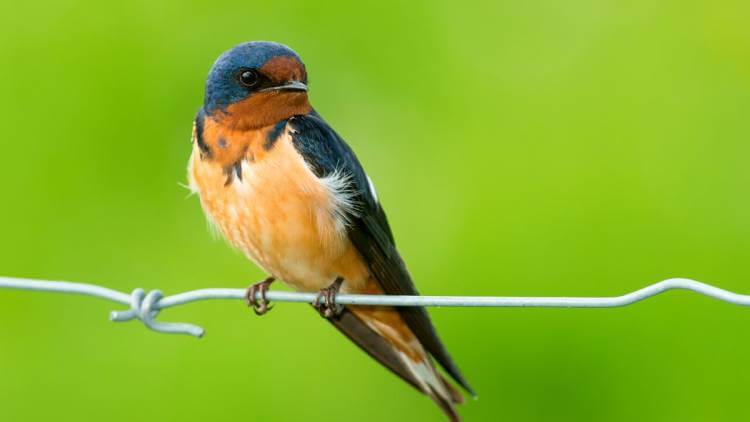
Barn Swallows in Florida can likely be found beneath bridges, as those offer them relief from the heat. They have a black-blue back, a long, split tail, orange breast, and belly. Females are a shade or so duller than the male. When in flight, the tail has distinctive white dots. Both sexes grow between 5.9 and 7.5 inches and weigh between 0.6 to 0.7 ounces with a wingspan between 11.4 and 12.6 inches.
They live in open fields, parks, meadows, and near roadways and feed on insects.
Yellow Birds in Florida
Yellow-Breasted Chat
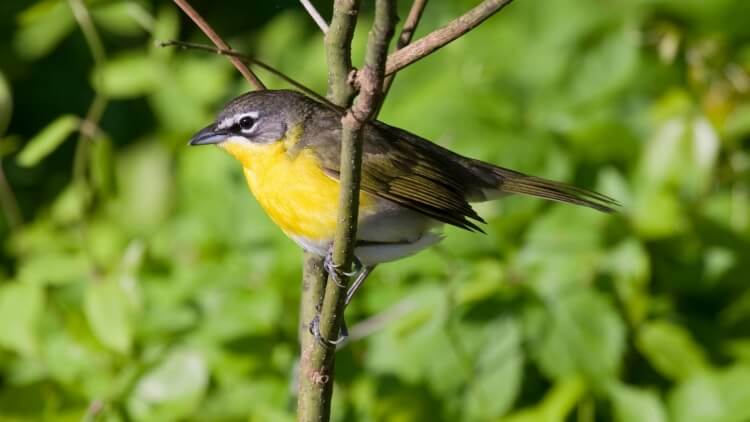
The Yellow-Breasted Chat breeds in northern Florida during the spring months. The male has a pure yellow breast, a green-gray head and wings, a white belly, and a long gray tail almost half its entire size. It can easily be recognized by the white “eye spectacles” on its face and white mustache. They grow to 7.1 inches in length and weigh between 0.8 to 1.1 ounces with a wingspan of 9.8 inches.
They live in shrubs and bushes, frequently along streams, and feed on bugs, caterpillars, bees, insects, and fruit.
Eastern Meadowlark
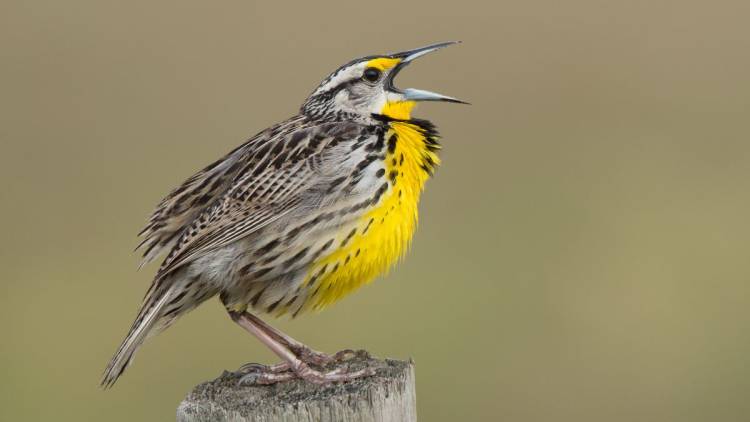
The Eastern Meadowlark can be found mainly in Florida’s rural areas. It is a medium-sized bird with a short tail and a thin bill. It has brown streaks on its wings and tail with a yellow chest. Its most recognizable feature is the large black V shape design on its chest. Both sexes grow to 7.5 to 10.2 inches in length and weigh 3.2 to 5.3 ounces, with a wingspan between 13.8 to 15.8 inches.
They inhabit fields and grassland and sit perched on utility lines and fence posts. The mainstay of their diet is insects, but seeds and grains are added during the winter months.
Western Kingbird
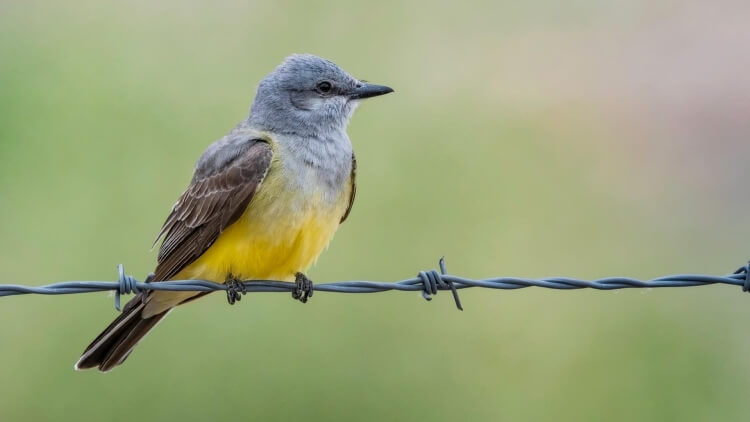
The Western Kingbird spends November through April in the southern part of Florida. The male has a large gray head and shoulders. The belly is yellow, with a white chest and throat and a black tail with white feathers that fan out when it is in flight. Both sexes grow between 7.9 and 9.4 inches and weigh 1.3 to 1.6 ounces with a wingspan between 15.0 to 16.1 inches.
They live in open areas such as valleys, grassland, fields, and open woodlands and feed on insects.
Birds in Florida by Species
Hawks

Red-Shouldered Hawks – Buteo lineatus – are medium-sized. They have brown and white checkered wings and tail with a rusty chest. Their head is a pale gray. They grow 16.9 to 24.0 inches in length and weigh 17.1 to 27.3 ounces, with a wingspan between 37.l0 to 43.7 inches. The Red-Shouldered Hawk lives in deciduous woodlands by rivers and swamps and preys on small mammals and frogs.

Northern Harrier – Circus hudsonius – can be seen during the fall and winter months in Central Florida before migrating north in the spring. They have a gray owl-like face with a hooked bill. The male has gray wings and a paler underbelly and noticeable black tips on the wings. Females have brown streaks throughout. Both have a white rump patch and hold their wings in a “V” position instead of horizontal. They grow 18.1 to 19.7 inches in length and weigh 10.6 to 26.5 ounces, with a wingspan between 40.2 and 46.5 inches. They live in open areas such as fields and marches and feed on small mammals, other birds, and small ducks.
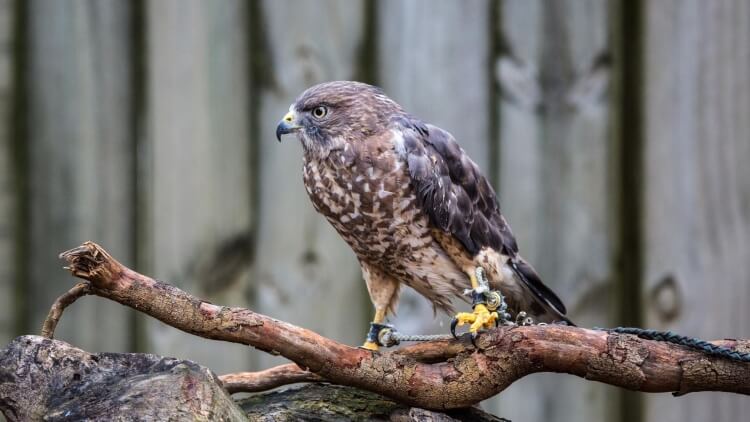
Broad-Winged Hawk – Buteo platypterus – can be spotted in northern Florida during the spring and summer and in Central Florida during the fall, and in the south during the winter during their migratory journey. These stocky birds of prey have a rusty-colored head, brown and white barred breasts, pale wings bordered in brown, and a black and white banded short tail. They grow 13.4 to 17.3 inches in length and weigh 9.3 to 19.8 ounces with a wingspan between 31.9 and 39.4 inches. They spend much time in forests near water and feed on small mammals, snakes, and frogs.
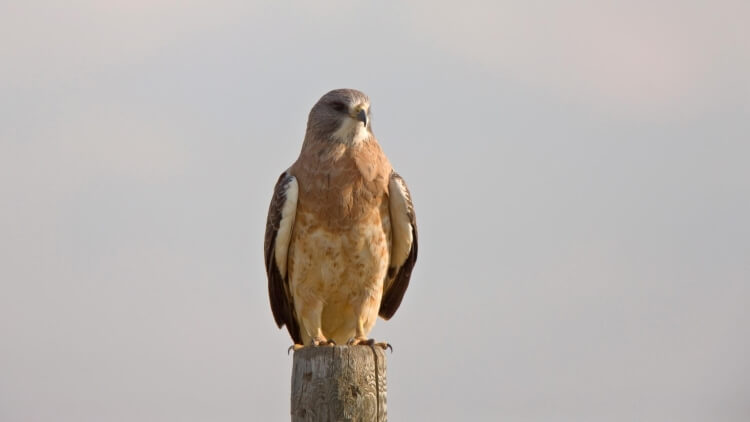
Swainson’s Hawk – Buteo swainsoni – can be spotted in southern Florida. They have long wings with short tails and have a mottled brown back and a lighter brown belly. Their underwings are distinctly white and brown. They grow 18.9 to 22.1 inches in length and weigh 24.4 to 48.2 ounces. They spend time in grassland and perch on utility poles and fence posts in search of rodents, snakes, mice, and rabbits.
Woodpeckers in Florida
Woodpeckers find a home in Florida’s many state parks.

Red-headed Woodpecker – Melanerpes erythrocephalus – is a year-round resident of Florida, where about 25 percent of the country’s Red-headed Woodpecker live. They have an unmistakable color palette – bright red head and neck, black wings with white patches, and a white underbelly. This woodpecker grows 7.5 to 9.1 inches in length and weighs 2.0 to 3.2 ounces with a wingspan of 16.5 inches. They live in pine forests and some wetlands where they feed on seeds, nuts, and fruits.

Downy Woodpecker – Dryobates pubescens is the tiniest of all Florida’s woodpeckers – almost a miniature of the classic woodpecker. Their wings are checkered black and white, with a black stripe across the eyes and a small red cap. The underbelly is white. They grow 5.5 to 6.7 inches in length and weigh 0.7 to 1.0 ounces with a wingspan between 9.8 and 11.8 inches. They live among deciduous trees, orchards, and parks where they feed on beetles, ants, seeds, and berries. They will happily visit a bird feeder for suet.
Owls in Florida
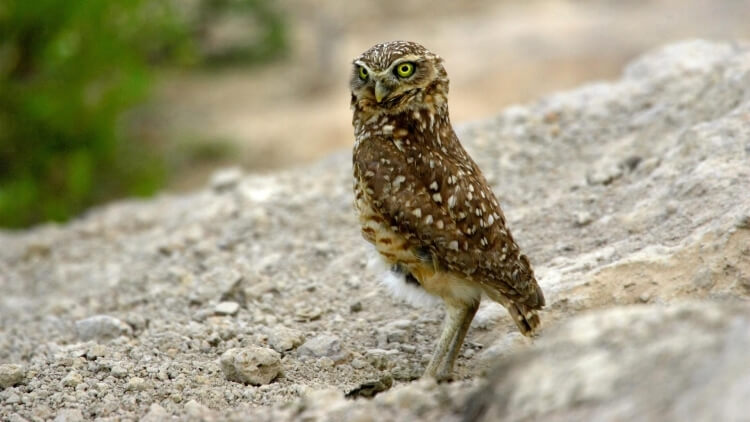
Borrowing Owl – Athene cunicularia – can be found throughout Florida, but especially in Cape Coral, which has one of the largest burrowing owl populations in the world. Adults are a mottled brown with pale spots on the underbelly. Their throat is white and their eyes yellow. They grow 7.5 to 9.8 inches in length and weigh 5.3 ounces with a wingspan of 21.6 inches. They live in open prairies, pastures, or desert terrain, where they feed mainly on insects and rodents.
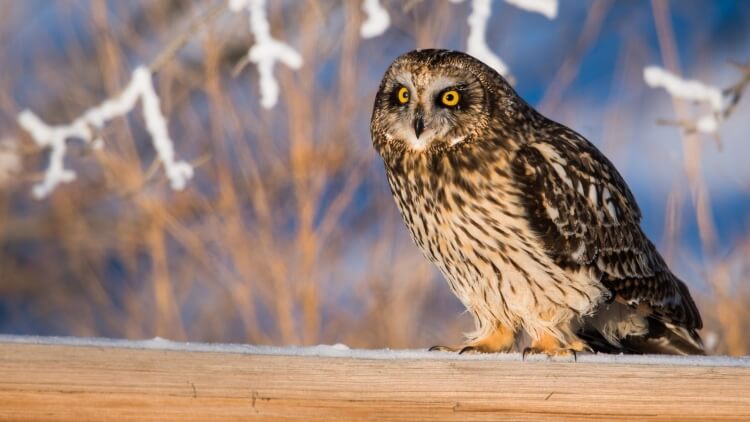
Short-Eared Owl – Asio flammeus – is a medium-sized owl that can be spotted throughout Florida. They have short, difficult-to-see ears – hence the name. They are a spotted brown with some white on the underbelly. The yellow eyes are outlined in black. Both sexes grow 13.4 to 16.9 inches and weigh 7.3 to 16.8 ounces with a wingspan between 33.5 to 40.5. They live in open country such as prairies, farmland, and shrubby areas and feed on rodents, mostly mice, as well as rabbits and gophers.

Barn Owl – Tyto alba – can be found throughout Florida and may be the beauties in the owl family. Their head, back, and wings are brown and speckled with rusty-colored spots. They are pale overall with dark eyes. They grow 12.6 to 15.8 in length and weigh 14.1 to 24.7 ounces, with a wingspan between 39.4 and 49.2 and inhabit farms, barns, and woodlands and prey on mice and rats.
Gulls in Florida
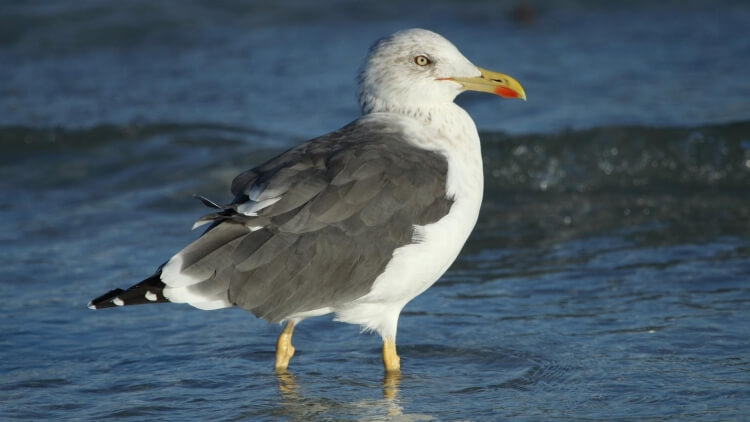
Lesser Black-Backed Gull – Larus fuscus – can be found in Florida during the winter months. They are medium-sized with long wings and a large head. During the breeding season, they are gray on top and white below, with a white head, neck, and breast, black wingtips, yellow legs and bill and a red spot on their bill. Both sexes grow between 20.5 to 25.2 inches in length and weigh 19.2 to 35.3 ounces with a wingspan between 53.1 and 59.1 inches. They inhabit cliffs and rocky coastal areas, as well as lakes and rivers during the winter. They prey on schools of small fish in the water or search land for rodents, bird eggs, and berries.
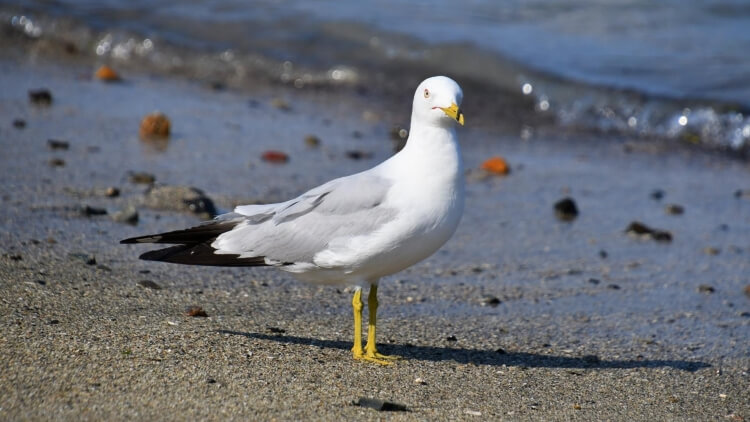
Ring-Billed Gull – Larus delawarensis – this gray and white gull can be found on most Florida beaches during the winter. They are gray on top, with most of the rest of the body white. The black wingtips are streaked with white, and they have yellow legs and bills. The bill has a black band, or ring around it, like an avian nose ring. They grow between 16.9 and 21.3 inches in length and weigh 10.6 to 24.7 ounces, with a wingspan between 41.3 and 46. l inches.
They reside close to humans, such as in parking lots, plowed fields, and parks. This waterbird may never actually see the sea, although many search out bodies of fresh water. Their diet depends on their location. They will feed on insects, grain, rodents, refuge, as well as fish.
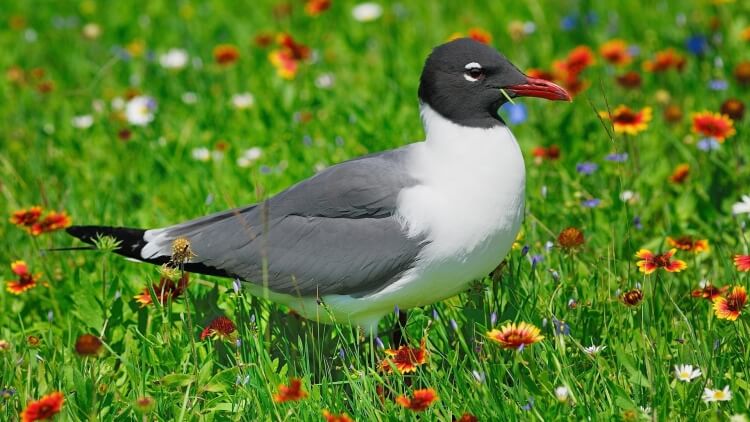
Laughing Gull – Leucophaeus atricilla – have colonies in the Keys, Tampa Bay, and along Merritt Island. They are medium-sized and have long wings and legs. They are gray above and white below with dark red legs and beak. They grow between 15.3 to 18.1 inches and weigh 7.3 to 13.1 ounces with a wingspan between 36.2 and 47.2 inches. They can frequently be spotted in parking areas, beaches where they will eat whatever they can forage or steal.
Further Reading on Florida Birding
For more information on birding in Florida, consider the following guidebooks:
- Tekiela, Stan (Author)
- English (Publication Language)
- DK (Author)
- English (Publication Language)
Visit these websites for additional information:


